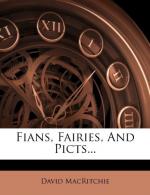Any attempt to reconcile the pygmies of the classic writers with actual dwarfs of flesh and blood is outside my province. Moreover, this has been admirably, and, as it seems to me, successfully done quite recently by M. Paul Monceaux, in an article in the Revue Historique,[18] wherein he compares the traditional and historical descriptions with the statements of modern travellers, and draws the inference that the pygmies of the Greek and Roman writers, sculptors and painters, are all derived from actual dwarfs seen by their forefathers in Africa and India. (Still less doubt is there with regard to the dwarfs in Ancient Egyptian paintings.) And whereas Strabo is, says M. Monceaux, the only writer of antiquity who questions the existence of the dwarfs, all the others are on the side of Aristotle, who says—“This is no fable; there really exists in that region (the sources of the Nile), as people relate, a race of little men, who have small horses and who live in holes.” And these little men were of course the ancestors of Schweinfurth’s and Stanley’s dwarfs.
But although M. Monceaux confines his identification to equatorial Africa and to India, he does not omit to state that Pliny and other writers speak of dwarf tribes in other localities, and among these are “the vague regions of the north, designated by the name of Thule.” This area, vague enough certainly, is the territory with which Fians and Picts are both associated; as, also, of course, the Fairies of North European tradition.
The attributes with which the “little people” of North Europe are accredited cannot be given in detail here. It is enough to note that they were believed to live in houses wholly or partly underground, the latter kind being described as “hollow” mounds, or hills; that when people of taller race entered such subterranean dwellings (as occasionally they did) they found the domestic utensils of the dwarfs were of the kind labelled “pre-historic” in our antiquarian museums; that the copper vessels which dwarf women sometimes left behind them when discovered surreptitiously milking the cows of their neighbours, were likewise of an antique form; further, that they helped themselves to the beef and mutton of their neighbours, after having shot the animals with flint-headed arrows; that melodies peculiar to them are still sung by the peasants of certain localities; that words used by them are still employed by children in their games; and that many families in many districts are believed to have inherited some of their blood.[19] Of this intercourse between the taller races and the dwarfs, there are many records in old traditions. In the days of King Arthur, when, as Chaucer tells us, the land was “ful-filled of faerie,” the knights errant had usually a dwarf as attendant. One of King Arthur’s own knights was a Fairy.[20] According to Highland tradition, every high-caste family of pure Gaelic descent had an attendant dwarf. These examples show the “little people” in a not unfriendly light. But many other stories speak of them as “malignant” foes, and as dreaded oppressors. Of which the rational explanation is that these various tales relate to various localities and epochs.




